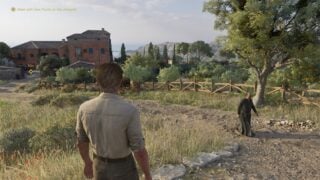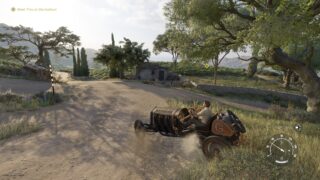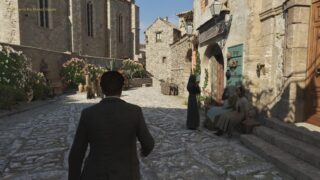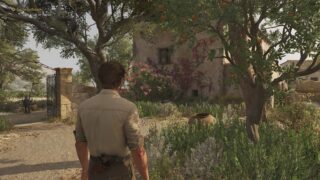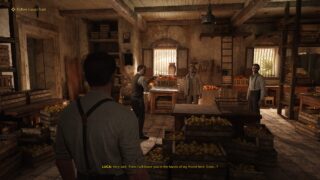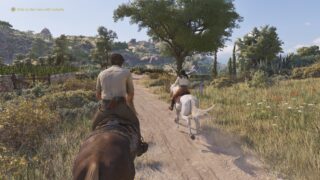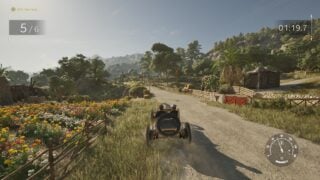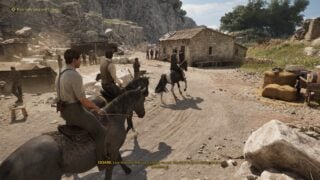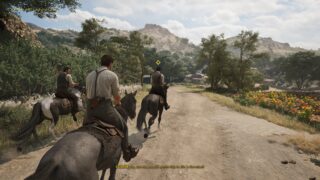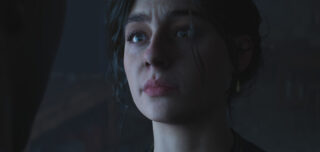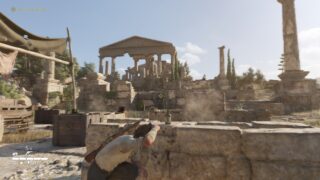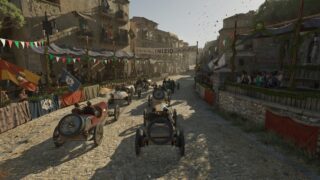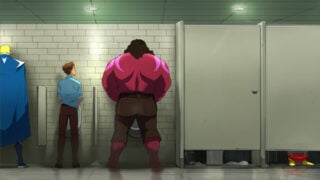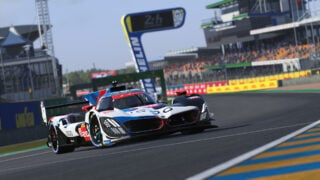Mafia: The Old Country review: A brief but beautiful Sicilian story
Hangar 13 returns to the series’ linear roots, at the expense of its stunning map
- Game director
- Alex Cox
- Key Credits
- Steve Noake (Art director), Valentin Galea (Technical director)
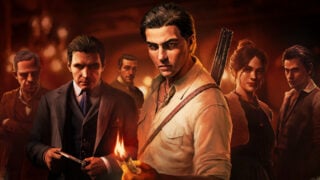
It’s been nearly a decade since the last new Mafia game, but ask certain series devotees and they’ll tell you it’s really been 15 years.
Mafia 3, which was released in 2016, told an interesting story but its shift to more open-world, district-based gameplay didn’t sit well with fans of the first two games and their more concentrated storylines.
Taking note of this, developer Hangar 13 has opted to take the series back to its roots – not only in terms of its gameplay, but its setting too – to deliver a shorter, more linear adventure.
The result is a solid game with an engaging storyline, while the decision to sell it at £45 / $50 will also be welcome to those worried that its lack of substantial open-world exploration might make it a hard sell at $60 or $70.
Mafia: The Old Country tells the story of Enzo, a labourer who’s spent his life working in a sulfur mine in Sicily. A tragic accident and near-fatal fight finds Enzo being taken in by the Torrisi family, where he’s put to work as an errand boy.
It doesn’t take Mario Puzo to guess that the game then follows Enzo’s rise up the ranks of this powerful family, with plenty of helpings of romance, surprise attacks and betrayal along the way.
Mafia: The Old Country – The first hour of gameplay
As has been stressed numerous times by Hangar 13 during its development, The Old Country is not an open-world game. To be clear, it does indeed have a decent-sized map taking in a little chunk of Sicily, but most of the time you’ll only see it when you’re riding or driving to the next location. The game even gives you the option to skip these journeys, making the world feel even more superfluous.
You shouldn’t skip them, however, because – at the risk of introducing one of the biggest clichés in game reviews – the environment is one of the best characters in The Old Country. Hangar 13 has done a tremendous job creating a beautiful version of early 1900s Sicily, from its dirt roads to its dense vineyards, to Mount Etna looming menacingly in the background.
This attention to detail extends to the other locations in the game, from the impressive Torrisi house to the colourful streets of San Celeste. You’ll want to gawk at every nook and cranny of these areas, and the game rewards you for doing so with a variety of collectable documents, hidden statues and charms.
The latter can be equipped on your necklace to give you extra powers, such as faster reloading, the chance to avoid gunshots and the like. As ever, some are more useful than others – once I unlocked faster aiming I never changed it – but it adds a little variety to a game that generally doesn’t allow much room for deviation.
You can’t be in the Mafia without getting your hands dirty, and for the most part The Old Country follows the same formula you’ll have seen in other action-adventure games, where you can attempt to stealthily make your way through each area, picking off guards without being seen, or – whether deliberately or after being caught – going guns-a-blazing, at which point the game becomes a cover shooter.
Nothing you’ll see here is revolutionary in any way, but that doesn’t mean it isn’t entertaining. Gunplay is solid enough, and picking off enemies from a distance with headshots is as hugely satisfying as it is in any game. There’s no need to always reinvent the wheel when sometimes it’s fine to just roll with what works.
Not everything works, though. Every major confrontation has to be resolved with a knife fight, and these are the weak point of the game. The idea is that you can parry weak attacks with one button, and dodge strong attacks (which have a little shine effect as they approach) with another.
Ultimately, though, it soon becomes clear that instead of keeping your wits about you and trying to quickly analyse and react to each attack, it’s just as effective to dodge everything then slash.
I appreciate the attempt to mix things up and make fights with key enemies more meaningful, but when the shooting is so enjoyable the knife fights feel more like the skits in a rap album – they’re a fun novelty at first but you soon want it to stick to what it’s good at.

Given its linear nature, The Old Country was always going to live or die by its story, and thankfully it’s an enjoyable yarn, if a relatively safe one. The cast are exceptional across the board, helped in no small way by the impressive character models, which are capable of delivering the most subtle expressions.
Each cutscene is a technical marvel, to the extent that you’ll forgive the game switching to 30fps every time one triggers (or at least it does on a high-spec PC on Epic settings, so I’d imagine it’s the case on console too). Numerous character close-ups wring every detail out of the facial performances, and the whole thing is a joy to watch.
(Speaking of the performance, at the time of writing it’s not known how the game performs on consoles because we were given PC code. On a rig with an RTX 5090 and Ryzen 7 9800X3D it runs smoothly on Epic settings at 4K for the most part, but there are still stutters here and there. It’s going to be interesting to see how it runs on PS5 and Xbox Series X/S, especially given that Hangar 13 has said the game will run at an “average” of 60fps in Performance mode on console, suggesting it may not always hit that.)

Enzo’s story is an engaging one too. It’s certainly not the most original – anyone who’s seen at least a smattering of mafia movies over the years will be ticking off the clichés in their head along the way, and will see the final main twist coming before the character in question does – but, as with the gameplay itself, the lesson here is that a plot doesn’t have to be groundbreaking if it’s delivered effectively enough, and I was still very much invested in what happened to him and those around him.
I played part of the game with my wife sitting next to me on the couch, and when I later told her that I had finished it she insisted that I tell her everything that happened, something that rarely happens when I review other titles. It may be a story all too happy to invoke every trope in the book, but sometimes the most well-trodden ground provides the most comfortable walk.
“It may be a story all too happy to invoke every trope in the book, but sometimes the most well-trodden ground provides the most comfortable walk.”
When the credits rolled after around 10 hours, I was left satisfied with what Mafia: The Old Country had offered. Its story kept me entertained without overstaying its welcome, its gunplay was a blast (pun always intended), and Hangar 13’s exceptional attention to graphical detail did justice to both the achingly attractive cast and the idyllic beauty of Sicily.
It’s the latter that feels like the most missed opportunity, however. I appreciate that fans of Mafia wanted the series to ditch the open-world nature of the third game and return to something more linear, so in one sense by complaining that it’s too linear I’m in danger of criticising it for not being something it was never trying to be.
That said, Hangar 13’s depiction of Sicily is so rich in picturesque splendour, it’s a crime – not quite up there with the deeds of the Torrisi boys, but a crime nonetheless – that such a detailed and appealing landscape is underused here.
There is an ‘Explore’ option – which is hidden away in the game’s chapter replay screen and which I would never have known about had I not been told about it by the developer – which mercifully lets you wander around the map, gathering most of the remaining collectibles scattered around.
While this gives you time to take in the sights at a more relaxed place and study the scenery in more detail, however, it also makes it all the more disappointing that there isn’t more to do there, as you walk down empty roads and wander through streets filled with people not saying anything to you. Purists be damned – I’d perform a hit for an open-world sequel that fills the countryside and its surrounding areas with NPCs and side quests.
“Hangar 13’s depiction of Sicily is so rich in picturesque splendour, it’s a crime – not quite up there with the deeds of the Torrisi boys, but a crime nonetheless – that such a detailed and appealing landscape is underused here.”
The level of detail in San Celeste alone is so striking – one mission teases what could have been with an Assassin’s Creed style rooftop chase – that it’s almost comical that one of the few times you visit it is to take part in a race where you zoom through it at high speed (and don’t worry Mafia 1 fans, the races here are much easier).
It speaks volumes of the quality of the game, however, that my main issue is that I wish there was more of it. It’s been said all along that this was always going to be a shorter, more straightforward affair, so in terms of what Hangar 13 set out to do, it’s very much mission accomplished.
By and large, Mafia: The Old Country is a great little adventure which, with its Explore option adding some replay value on top of the 13-15 hours it takes to beat the main story, is well worth the $50 asking price (incidentally, the $60 Deluxe Edition’s extra skins and cars aren’t essential, so it should only be considered if you want a digital soundtrack and digital art gallery, the latter of which contains some interesting developer notes).
As long as you go into this game knowing that you’re getting something ‘old’ both by name and by nature – an adventure that harks back to the PS2/3 era where you just played through the story, reached the credits and moved on without any live service gubbins or microtransaction – and aren’t expecting much of a post-game beyond gathering the remaining collectibles, it’s highly recommended.
Mafia: The Old Country returns to the series' roots with a more linear adventure, delivering a solid story (if a cliché-heavy one) and satisfying combat. The character models and environments are stunning to look at, but the latter raises our main issue: as much as we appreciate the focus on a linear story, this wonderfully sculpted Sicily map is begging to be explored more and is sorely underused as a result.
- A visually stunning rendition of 1900s Sicily
- Fantastic cast performances backed up by great capture animation
- Simple but entertaining cover-based gun combat
- An engaging story that doesn't overstay its welcome
- Knife fights with bosses are dull
- This impressive Sicily map is wasted on a non-open-world game





